“Some of the worst offenders in the Clean Label Project’s tests were organic, plant-based protein powders. More than 75 percent had measurable levels of lead. And certified organic products averaged twice the heavy metals of their uncertified counterparts.”
Mercury Contamination: A Critical Issue
Last month the FDA advised pregnant women and women of childbearing age who may become pregnant (as well as nursing mothers and young children) not to eat shark, swordfish, king mackerel and tilefish. These fish, said the FDA, may contain high levels of a mercury called methyl mercury that may harm an unborn baby’s developing nervous system. Some experts on the ABC television show 20/20 also advised against eating tuna, but the FDA rejected calls to put tuna on the do-not-eat list stressing that swordfish and shark have far higher levels of mercury.
As you’re probably aware mackerel and tuna contain significant quantities of the fatty acids DHA and EPA and are often the source of these nutrients manufactured in fish oil capsules.
It is quite understandable that many parents giving such supplements to help their children with ADHD, dyslexia and dyspraxia (or taking omega-3 for personal health reasons) should be alarmed by the contamination reports. It is a serious issue and before making any recommendations it is worth reviewing the history of the problem.
The Mad Cats of Minamata
The danger of mercury contamination was discovered in 1953 when fish, contaminated with mercury, first drove cats mad and then killed and maimed people in a fishing village in Minamata Bay, Japan.Mercury is one of a group of substances called heavy metals. Other members of the group include selenium, chromium, cadmium, manganese and lead. Some of these heavy metals are essential in the diet (selenium, chromium and manganese), but all of them are toxic when taken in excessive amounts.
There are three forms of mercury that are used by industry––metallic mercury, organic mercury compounds and inorganic compounds. All forms of mercury are poisons but some are less dangerous than others are. The inorganic forms are the least dangerous and the organic forms (for example, methyl mercury) the most dangerous. Unfortunately, when industrial waste including inorganic mercury is discharged into rivers, lakes and the sea, the sediments including microorganisms and animal life convert it to the more toxic organic methyl mercury. This is what happened in Minamata Bay and is happening in contaminated lakes, estuaries and rivers worldwide today. And this is what concerns the FDA and the Environmental Protection Agency (EPA). The greatest risk is from the fish mentioned by the FDA because they are long-lived, larger fish that feed on smaller fish and therefore accumulate the highest levels of methyl mercury. These fish would be perfectly safe to eat if they lived in uncontaminated waters. Much of the tuna that’s caught lives in clean South Pacific waters.
So, What Should You Do?
Unfortunately, the very groups of people advised not to eat king mackerel and tuna are those with a great need for the fatty acids that these fish contain––anyone likely to get pregnant, moms-to-be, nursing mothers and young children. It is a great pity that the safety of these fish is in question, but the advice must be heeded and only uncontaminated fish consumed. The EPA has information on which places are contaminated and where fish is safe to eat. Most people, of course, now choose to obtain the vital fatty acids by consuming fish oil supplements such as those mentioned in my book, “The LCP Solution: The Remarkable Nutritional Treatment for ADHD, Dyslexia and Dyspraxia.” Reputable manufacturers of fish oil supplements regularly monitor their products for heavy metal contamination, so one way to get around the problem is to take a fish oil supplement that is free from such contaminants.
Most people, of course, now choose to obtain the vital fatty acids by consuming fish oil supplements such as those mentioned in my book, “The LCP Solution: The Remarkable Nutritional Treatment for ADHD, Dyslexia and Dyspraxia.” Reputable manufacturers of fish oil supplements regularly monitor their products for heavy metal contamination, so one way to get around the problem is to take a fish oil supplement that is free from such contaminants.
How can you be sure? A large, reputable manufacturer is going to do everything in its power to ensure that its products are not contaminated. It is not worth its while running the commercial risk of putting such products into the marketplace. But be an aggressive consumer! Contact the manufacturer of your preferred fish oil supplement. Ask them directly if their product contains mercury and if they screen every batch of fish oil they use. If you obtain a quick response and an explanation of how they monitor their product you can be reassured of its safety.
Best wishes,
Dr. Jackie Stordy and Malcolm Nicholl (who is also co author of The Late Talker book!)
Environmental Toxins: Mercury, Lead, Pesticides | Keeping Kids Healthy -an interview with Dr. Jill Stein. Includes how a young boy’s love for tuna fish got him very sick.
Mercury in canned tuna still a concern New tests reinforce a need for some people to limit consumption
Results from our tuna tests, conducted at an outside lab, underscore the longheld concern for those people. We found:
- Every sample contained measurable levels of mercury, ranging from 0.018 to 0.774 parts per million. The Food and Drug Administration can take legal action to pull products containing 1 ppm or more from the market. (It never has, according to an FDA spokesman.) The EPA compiles fish advisories when state and local governments have found high contaminant levels in certain locally caught fish.
- Samples of white tuna had 0.217 to 0.774 ppm of mercury and averaged 0.427 ppm. By eating 2.5 ounces of any of the tested samples, a woman of childbearing age would exceed the daily mercury intake that the EPA considers safe.
- Samples of light tuna had 0.018 to 0.176 ppm and averaged 0.071 ppm. At that average, a woman of childbearing age eating 2.5 ounces would get less than the EPA’s limit, but for about half the tested samples, eating 5 ounces would exceed the limit. (read more)
More from 20/20
“20/20 discovered that while the tuna samples averaged well below the FDA limit of 1 part per million (ppm), the shark and swordfish did not fare as well. Two out of four shark samples and 14 out of 18 swordfish samples had mercury levels greater than 1 part per million. Two of the swordfish samples tested had mercury levels triple the FDAs limit.
When 20/20 presented its findings to Dick Gutting, he could not explain the results but said that the fact that one particular meal is over one part per million is not significant. Gutting stressed that the average level of mercury in commercially sold fish is well below the FDA limit. Both the fish industry and the FDA say that there is a ten-fold safety factor built in to the 1ppm limit.
But Dr. Jill Stein, of the Boston Physicians for Greater Responsibility, disagrees. She says that even one meal of swordfish with levels between 2 ppm and 3 ppm could potentially harm the fetus at a critical point of brain development.
Both the fish industry and the FDA say that there is no evidence that people are eating enough of this high-mercury fish for it to be a problem. However, Dr. Jane Hightower of San Francisco, Calif., has several patients who eat large amounts of high-mercury fish in question and have blood-mercury levels as high as 15 times the normal level. Hightower says when her patients cut down on such fish, their blood-mercury level drops to normal level. ” Read more Find more information about mercury at the Cherab website
And it’s not just fish. Mercury is found in the environment -the air, the water and in all life.
From the National Wildlife Federation: Poisoning Wildlife: The Reality of Mercury Pollution
HIDE AND SEEK TOXIC LEAD, IT’S NOT CHILD’S PLAY
“Speech disorders and learning disabilities did not run in either my mom or dad’s family. Genius runs in my mom’s side of the family. Most people assume if you grew up across the street from factories you are in low income housing not -in NJ.
In the picture, I am with my little niece Chelsea whose speech impairment is mild in comparison to her brother’s -and her cousins’ (including Tanner and Dakota who inspired the book The Late Talker)
Ironically –fish oils are one of a few food sources that help the body naturally detox. And fish oil is one of the best ways to consume the essential fats sans mercury. Mercury binds to the protein (muscle) of the fish and has not been tested by the FDA and others to be found in the oils. That includes even testing of cheap unstable fish oils which in most cases have high peroxide levels (translate- they are rancid due to oxygen exposure). There are other foods that naturally help the body detox including the foods in my patented nutritional composition IQed such as the whey isolate protein. We need to do more to protect our children from heavy metals -and choosing organic has been found to be higher in heavy metals
“Some of the worst offenders in the Clean Label Project’s tests were organic, plant-based protein powders. More than 75 percent had measurable levels of lead. And certified organic products averaged twice the heavy metals of their uncertified counterparts.”
Read more Environmental Clusters? Written by Lisa Geng
LISA GENG

